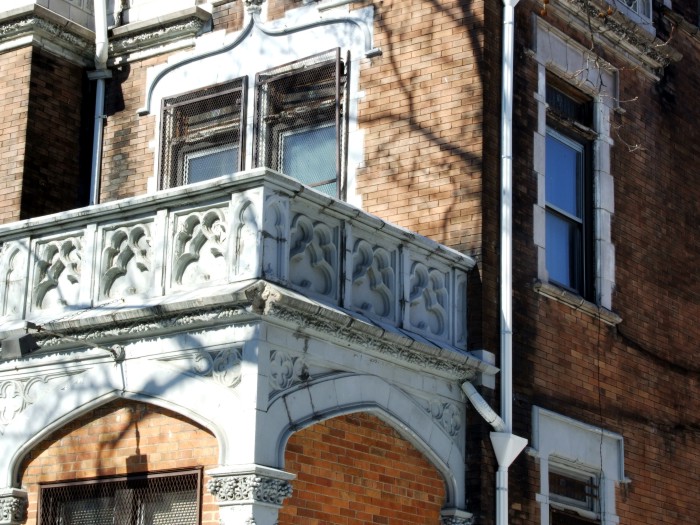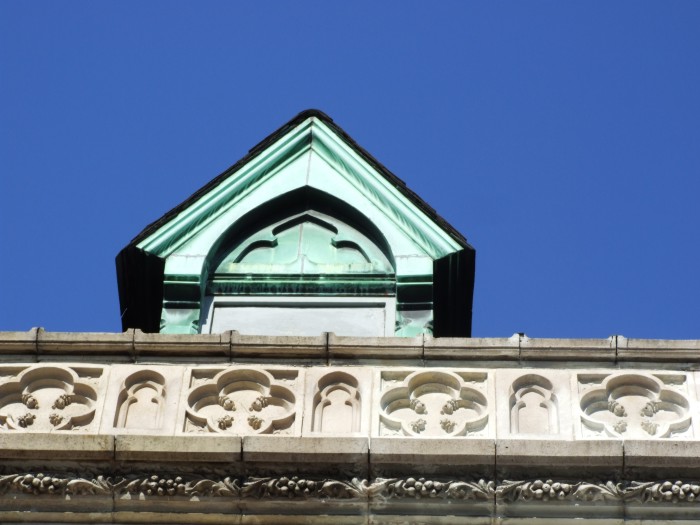Walkabout: The Jacob Dangler House on Willoughby Avenue
Editor’s note: An updated version of this post can be viewed here. Read Part 2 of this story. The house sits on the northeast corner of Willoughby Avenue at Nostrand Avenue, seemingly empty, sprawling behind a chain link fence. It’s on a large lot, and the house itself, a golden brick and limestone French Gothic…

Photo by Greg Snodgrass for PropertyShark
Editor’s note: An updated version of this post can be viewed here.
Read Part 2 of this story.
The house sits on the northeast corner of Willoughby Avenue at Nostrand Avenue, seemingly empty, sprawling behind a chain link fence. It’s on a large lot, and the house itself, a golden brick and limestone French Gothic pile, is totally incongruous with the much more modest brownstone neighbors on the block. A block away and across the street is the Bedford Stuyvesant branch of Home Depot, and for thousands of people visiting the store, or waiting for the Nostrand Avenue bus across the street, this house may be a fleeting mystery, glanced at when passing through the neighborhood. Even those who don’t care about these things wonder what it was, or how it came to be there. Was this a rich family’s mansion? Who were they? Why did the house sit here, and what’s it being used for now? Is it abandoned? Empty? Has anyone ever been inside?
Well, I’ve been asking those questions for more than thirty years. I saw this house on my first trip down Nostrand Avenue coming into Bedford Stuyvesant, when all of Bed Stuy was a mystery to me, and I’ve long been curious about its former and current inhabitants. Since I fantasize about rescuing houses the way some people rescue stray animals, I’ve always wondered what it would be like to live there, rattling around in that huge house like a rich old recluse, while the neighborhood around you changes over the years. Did anyone actually do that? It turns out the answer to that is no.
I’ve also wondered about how much money it would take to restore a mansion like that, and what are the chances that will happen? How would it look with the porch opened up again, with the windows repaired and the stained glass transoms recreated? How much would it cost to replace the slate roof? What about landscaping around the grounds and the chain link fence replaced by a proper black wrought iron fence, perhaps one with an ornate gate, as befits this French fantasy? And inside? Who knows? This house is a whopping 58×85 feet, with over 12,000 square feet of house. Who the heck lived here?
That question was relatively easy to answer, and given that the house is in the Eastern District, on the far northern side of Bedford Stuyvesant, it shouldn’t come as a surprise that the man who commissioned the house was of German ancestry, as were most of the wealthy men in this part of town. This was the home of Jacob Dangler and his family, and he was a very successful purveyor of meats and provisions. At least that’s how his empire and long career started.
Jacob Dangler was born in Alsace-Lorraine in 1851, the son of farmers. At that time, this border state belonged to Germany, although now it is a part of France. Dangler came to the United States, landing in Brooklyn at seventeen. He had an aunt here in Brooklyn and was soon able to gain employment in the grocery business under Henry Meyer, another German grocer who would end up being one of the largest tobacco manufacturers in Brooklyn and Queens. I wrote about him for Brownstone Queens, here and here. After a year with Meyer, Jacob Dangler moved on to work for Andrew Harman, who had a provisions store on Broadway, in Williamsburg.
Young Jacob discovered he liked provisions, which are what we today call deli meats and cold cuts. He worked for Harman for ten years, learning the meat processing business, and how to make the finest processed meat products, especially from pork. Like many German immigrants, Dangler saved his money, and during this time, got married, and bought a house in Williamsburg, on South 5th Street. He also began plans to start his own business, and in 1880 opened his own meat and provisions establishment at 734 Myrtle Avenue. Mrs. Dangler was not just a stay at home wife; she also helped him in the store, and was the bookkeeper for his business. The couple also began a family, and had three sons.
In 1884, his establishment on Myrtle was just too small for his rapidly growing business, and he moved to a larger facility on the corner of Myrtle Avenue and Wallworth Street. In time, he greatly expanded on this facility, using Brooklyn’s most prolific German American architect, Theobald Engelhardt, to design all of the additions, garages and other changes to his property. The family also moved to 734 Myrtle Avenue, just down the block from the business.
By the turn of the 20th century, Jacob Dangler’s business had grown to the extent that he was a wealthy man. Like many wealthy men, he had been approached to join the board of at least one bank, and he was also a real estate investor and landlord, with many residential properties in the Eastern District that he both rented out and bought and flipped. But he was still living in a rather non-descript home on Myrtle Avenue. It was time for new digs worthy of his status. He commissioned a mansion for a piece of property he had bought on the corner of Willoughby and Nostrand Avenues.
I tried to find the architect of this house everywhere in my on-line resources, but came up empty. But since Theobald Engelhardt designed not only Dangler’s factory, but also several houses on property he developed, I would not be surprised to find out that Dangler came to him for this project as well. Engelhardt was certainly able to come up with this design and oversee the execution. The house is rather interesting in many ways. First of all, the location. It’s only a short walk to Dangler’s business, and I think that was very important to him.
This neighborhood was never upscale. In fact, by the time this house was built, industry was well established on all of the blocks west of here. There were all kinds of factories near here, making all kinds of products. There were lots of homes, as well, with streets of row houses, as well as tenement and flats buildings. There were enough children in the area that a large school would go up a block or two away, a beautiful Snyder school, only a short number of years from when the house was built.
The block the house sits on is full of Neo-Grec brownstones, on both sides of the street, built in the mid to late 1870s. It was a nice, middle class row, but not the location where one would think a fine mansion would be. A few blocks east of here, on Willoughby, were the large houses of other successful German businessmen, but down this way, Dangler’s house stood alone in its splendor.
The style of the house is interesting, as well. Perhaps Dangler wanted a building that reminded him of that part of Europe that he called home, an area that was pulled between Germany and France with great regularity. When his father had been born in Alsace-Lorraine, it was French. By the time he came along, it was in German hands again.
The design is pure French Gothic, not a style that you see all that often in Brooklyn, although there are other great examples. This was around the same time Montrose Morris designed the French Gothic Clermont Apartments on Decatur Street, not all that far away in Stuyvesant Heights. Also in Stuyvesant Heights, on Decatur Street, and in the St. Marks District, on Park Place, Axel Hedman and Magnus Dahlander had designed some very lovely French Gothic row houses in the 1890s. Perhaps Dangler had admired these, as well.
Dangler was also a very pious and religious man. He was a dedicated church-goer, and a leading member of his Lutheran church, St. Peter’s Church, on the corner of Bedford and DeKalb Avenues. Jacob had been a member for many years, and was president of the board of trustees there. One of his sons, Henry, even married the pastor’s daughter. The very Gothic elements of the house’s design could also reflect his religious side. The exterior abounds with trefoils, quatrefoils and other “churchy” elements so familiar to Gothic architecture. But then, I could just be over-thinking it. Perhaps Jacob Dangler just wanted a French castle on his little corner of the universe, where he could be king.
By 1902, the house was finished, and the family moved in. For the first time, the Dangler’s activities began to be noticed in the papers, but it still amazes me that nothing was written about the house when it was built. Much smaller and less ornate homes, albeit in tonier neighborhoods, were gushed over all the time by the reporters of the Brooklyn Eagle, who loved to describe every detail of a home, down to the floorboards, wainscoting and cupboards. This house would have been a very desirable target for that market, but there is nothing. Perhaps the Dangler’s were just too modest and self-effacing, and didn’t like showy publicity.
But the Dangler family and the provisions business went on about their business, and news would follow. Please join me next time for the conclusion of the story of the Dangler family and this extraordinary house. GMAP







What's Your Take? Leave a Comment